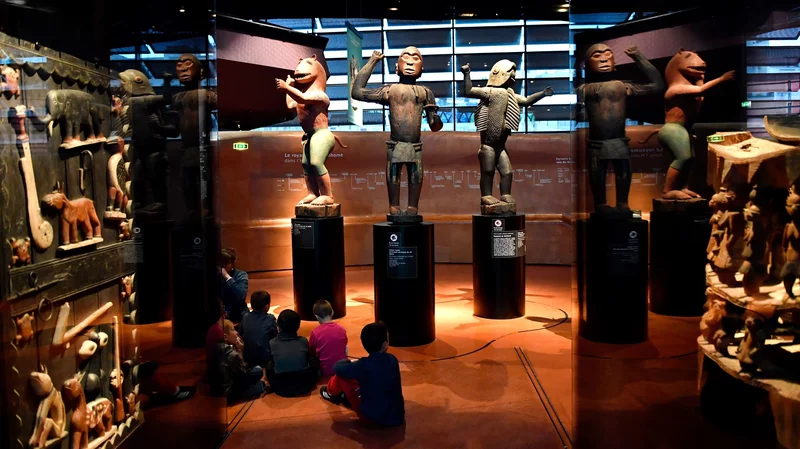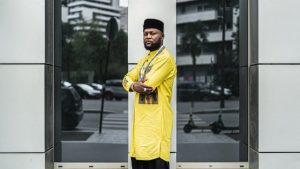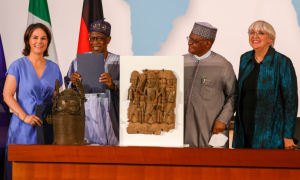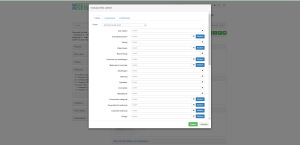
It’s still in the museums.
The colonized way of returning objects.

Mwazulu Diyabanza, activist and head of the UDC.©Bardos Florent/ABACA
On the 10th of September 2020, a group of activists, headed by Mwazulu Diyabanza, walked into the Afrika Museum in Berg en Dal. Inside Diyabanza took one of the wooden funerary statues that were on display. This statue, as Diyabanza claimed, was stolen from Africa and taking it back with him was therefore a righteous act. This has not been the first time that Mwazulu Diyabanza took objects from museum exhibits, among which from the Quai Branly Museum and the Louvre in Paris. As a result of these actions Diyabanza has been tried and fined by Dutch and French courts of law (Brown, 2021; BBC News, 2020). Along his work as an pan-africanist activist he is also the head of; Unite, Dignite, Courage (UDC), an activist group that has since 2018 been calling for the restitution of stolen objects in French museums (Guedj, 2020). The group has around 37.000 followers on their Facebook platform, which indicates that the work that Diyabanza and his colleagues do is very important for a large group of people.
Diyabanza is often criticized for the actions that he takes. This critique often comes from a type of discomfort and/or a lack of knowledge about an objects past, but just as important, the legislation around the repatriation of objects.
Empty promises
African heritage cannot solely exist in private collections and European museums.
African heritage must be showcased in Paris but also in Dakar, Lagos and Cotonou; this will be one of my
priorities.
This is what Macron said in a speech at the University of Ouagadougou in Burkina Faso (élysée, 2017, for the full speech and video). The goal of the speech was to start developing stronger ties between both France and Burkina Faso. In front of 8000 students, members of the parliament of Burkina Faso and the then President Kaboré, Macron made the promise: “Within five years I want the conditions to exist for temporary or permanent returns of African heritage to Africa.” (élysée, 2017). A major step is the report “The Restitution of African Cultural Heritage. Toward a New Relational Ethics.” (Rapport sur la restitution du patrimoine culturel africain. Vers une nouvelle éthique relationnelle) by Felwine Sarr and Bénédicte Savoy. This report serves as an initial investigation of unlawfully obtained African artifacts in French public collections and offers plans of what steps to take next in the process of restitution (Sarr and Savoy, 2018).
Within the report there are also some suggestions of which objects could already be repatriated (Sarr and Savoy, 2018 p. 63-66). As a result of these, in the period between 2021 and 2022, 26 objects were returned to the country of Benin, a crown to Madagascar and lastly the El Hadj Omar sword to Senegal (ben Mohamed, 2022).

Signing of the agreement to return the Benin Bronzes to Nigeria 1 July 2022. (left to right: Annalena Baerbock, Lai Mohammed, Zubairo Dada, Claudia Roth)
Even though this is just an example from France, it definitely is not the only country that decided to take action with regard to their public colonial collections. Germany for example returned 22 Benin Bronzes to Nigeria (Ahn, 2022), while the Netherlands took this moment to take critical look at their own repatriation practices (Broom 2021).
It is of course very understandable that, if you lost your cultural heritage through unlawful means, that this all sounded very hopeful in that five year period after Macron’s speech in 2017.
Yet looking at the relative numbers of repatriated objects the story is completely different.
In the Sarr and Savoy report (2018 p. 63-67) there are actually between 40 and 50 objects suggested for repatriation from a total of 6 countries, from which Ethiopia, Mali and Cameroon still have not received anything. Furthermore there are an estimated 90000 African objects in French public collection. Furthermore Germany has about 1130 Benin Bronzes, of which they have repatriated 22, but have stopped this process as of 2023 (Sevillano, 2023). The Netherlands, even though having been repatriating objects for a slightly longer period than other countries, about 2010’s onward, there are still large amounts of African objects in the collections of various museums.
The process
The beginning
So why are so little objects actually being returned? Well it might be useful to go through the procedure together to get some insight into how this process works.
In order to even be able to start the process of repatriation you will need access to the internet. Here you can find the online database collections for bigger museums like the British Museum (United Kingdom), Wereldmuseum (Netherlands), Rijksmuseum (Netherlands), Pitt Rivers Museum (United Kingdom), Koninklijk Museum voor Midden-Afrika (Belgium), Musée du Quai Branly (France) and the Louvre (France) (all the museums have a link to their online databases, if you need them but cannot find them). So, if you are lucky the object that you want to claim can be
found in one of these databases, but you will still have to find them.

The database of the Wereld Museum (the Netherlands)
With generally speaking between 90-100 thousand items in one database it is impossible to go through them all one by one, so you will need to apply filters. Most databases have some standard filters, but these are generally speaking too broad for searching something specific, so you would need to apply more specialised filters (see the Wereldmuseum image as an example).These types of filters are more specific but require some sort of basic understanding of how databases work.
But lets say that this process is not too overwhelming for you (it, of course, is not an impossible task), you then need to send an official claim to a curator, museum or head of museum. A claimant can be a government, a group of people, or an individual, so everyone can place a claim on a specific object. But with each claim you will also need to hand over evidence that it was taken from you forcefully and that you were the previous owner. If you have done that, and the museum accepts to look into your claim from that point forwards the research is out of your hands.
Provenience
When you filed the claim it is up to the museum to research their own collections. This is done through provenance research, this kind of study tries to determine where objects come from based on material studies, ethnographic approaches but most importantly the study of archival material, purchase histories, old museum records etc.

Provenance research, inside the archives. (Denver Art Museum)
In this research it will also be determined if the object could have been obtained lawfully or not. Not all objects in museum collections are unlawfully obtained, some could have been bought, from trusted dealers, or they are clearly proven to be gifts. If, by modern day standards, an object was taken under duress (stolen, obtained through exploitation etc.) it would be eligible for repatriation. However, it is not up to you how involved you are in this process. Museums are not required to work with you. Some researchers will ask you for your opinion, others might not. You are often not allowed to see the documentation in the archives, let alone see the object you claimed, or other objects which might be in storage.
Check listing
With the term “check listing” I am referring to the creation of criteria that need to be followed and checked off in some way, for you to be able to receive the object that you claimed. There is no way for you to influence whether or not specific boxes are checked off, but you are heavily reliant on the fact that they are if you want the object you claimed.
In order to understand what is happening here, we will turn to the Wereldmuseum’s: Return of Cultural Objects: Principles and Process (Wereldmuseum, 2019). This is one of the few online available guide about the process of returning objects. So what can we learn form this document?
If you want to have your claim returned to you it needs to have been proven that:
“4.2 It can be shown that the cultural object(s) was collected/acquired in contravention of the standards of legality at the time. This includes but is not limited to cases where the cultural object was”
“4.3 It can be shown that the claimants were involuntarily separated from the cultural object(s). This includes, but is not limited to conditions where the cultural object(s) was:”
“4.4 It can be shown that the cultural object(s) is of such value (cultural, heritage or religious) to nations and/or communities of origin that continued retention in the collection of the NMVW can be tested in relation to analogous standards articulated by The Heritage Act (Erfgoedwet) 2016 for Dutch national heritage and culture.This includes a cultural object(s):
If you want the object that you claimed back, than one of these points has to be checked. If you are lucky either 4.2 or 4.3 have been proven to be the case during the provenance research. When it is not cleaer where the object exactly comes from is not always clear and then you are reliant on whether the msueum thinks 4.4 can be the case. When, at any point, none of these criteria have been proven the object will not be returned. If one of these criteria has been proven it will go past another checklist (Wereldmuseum, 2019 p. 7). These are the guidelines, and they are there for extra considerations.
5.3.1 Standards of continued custodianship
5.3.2 Cultural heritage and identity
5.3.3 Cultural continuity/genuine link
5.3.4 Just and fair solutions
if at any point the museum thinks that one of these considerations is not applied to well enough the return will not continue. So if the provenance research has shown that the object you laid claim to was provably stolen, then the museum could still deny your request on the basis that they think you could not care well enough for it (5.3.1). And just like with the rest of the process, there is no way for you to influence what decisions are made.
Even though these regulations do not sound good, they are a lot better than what other museums offer. There are no clear instructions for returning objects found in Germany, Belgium or France (with exception to Sarr and Savoy, 2018). Most egregious, and most famous example is of course the British Musuem, which, according to the British Museum Act of 1963, is not allowed to permanently remove objects from their collection, with few exceptions (British Museum, 1963).
Before turning to the reflection on the process just discussed, I feel like it is important that we understand that this has been talk about legislation, and not necessarily that conduct this research. Most researchers are highly sensitive and understanding to the social dilemmas that come with provenance reserach. It is because of these researchers that the communities of origin (a term used to refer to group of people that objects came from) are often invited to take part in the actually provenance research, where they are the experts and the researchers are there to learn from their expertise. This, however is not always the case, but generally speaking the problems in provenance research are with the institutions that maintain the collections.
It is quite clear that in the process of decolonization, heavy colonial practices can still be found.
There are a few presupposed skills and necessities that you have, like technical skills, time (to conduct your own research), connection to the internet and more. Individuals or groups of people do not always have the luxury to acquire the nescessitated skills and requirements, which indirectly supports the governmental institutions, where there are many more people that can work on that same job, thereby legitimizing governmental institutions, which were directly the result of colonial interference on the continent. Furthermore governments do not always have the same aims with the repatriation of objects as individuals or minority groups would have, and it would therefore still be misappropriated. Again as a result of this legitimization of governmental institutions. A great example of this is Mexico, where the government is actively claiming artifacts belonging to Yucatán Mayans, but not because the government returns it to them, but because it will fill a new museum, thereby still monetarily exploiting that particular minority group (Córdova, 2021). Looking further at the the provenance research is still heavily reliable on colonial knowledge structures. The research will always be arranged by the institutions who appoint “specialists” and if a community of origin are asked, it is to advice on the case, but this does not always have to be the case. Furthermore if a museum cannot determine what the provenance is of the object of their studies, it is not forced to do anything, it could just turn down the claim, based on a lack of evidence on their side. This is a typical power balance that does not befit the decolonization that these institutes strafe for. This agency for the institutes is also visible in the check listing part of the process. It makes the whole process highly dependent on the institutions, and understanding of terms, like value, will always be through a eurocentrist view. Yet we work with objects that come from regions that do not always subscribe to the same explanations that the eurocentrist view gives. Europe, in this matter, still heavily enforces their organizations and values on countries, and peoples that may not ascribe to the same ideas. While it is just expected for them to follow the rules that we set out, for them to gain their objects back.
One of the best examples of this is the stop of the Benin Bronzes that were being repatriated by Germany to Nigeria. In total Germany was planning to return 1130 Benin bronzes, but earlier 2023 stopped this process after just 22 had been sent over. This was the result of Germany back paddling on their agreement, after they found out that the NIgerian government decided to send the bronzes the the Oba (king) of the Kingdom of Benin, from whose family these were stolen in 1897 during the British “expedition” (Sevillano 2023). Germany stopped the repatriation process because they are afraid that the Oba cannot take care of these objects as well as it become privately owned instead of publicly. Before this process continues German parliament will have to discuss this first, before there is even a change for the other bronzes to be returned.
This just show the amount of power these old colonizing countries hold in this hierarchy, while they were aiming to create a more equal playing field for everyone.
We have to start striving for a more open co-creation of knowledge, where communities of origin and individuals can be part of the research. A great example is the research conducted by Ellen Pearlstein (an academic) and Chuna McIntyre (a representative for the Yup’ik people from western Alaska).In their research on Yup’ik masks located in the Vatican Museum, Ellen and Chuna play equally important parts, and articles that stem from this are always co-authored (Pearlstein and McIntyre, 2022). We need to get away from the existing knowledge hierarchies, in which the academics and the institutions are taken as the ultimate idea of knowledge start including more non-academic interesting parties, and especially the claimants, more than we are now.

Dahomey royal statues returned by France to Benin. Seen in their old exhibition on the feature image on the top of the page.
They went out to steal, and they stole a part of me. They stole a part of my history, a part of my identity.
This is a quote from Mwazulu that encapsulates what he has been fighting for (Diyabanza, 2021). He fights for the return of the culture that “they” (the Europeans) took from Africa, and he is doing everything in is power to gain that identity back. He is often portrayed by European media as a thief, either good or bad. Diyabanza is criticized a lot by the institutions that he has taken objects from, yet he will never call himself a thief, as you cannot steal objects that have been stolen by someone else. I would argue that we (westerly educated people) should not judge so quickly on the actions that are performed by Diyabanza. he has never kept anything that he tried to take from an exhibition and has never destroyed an artwork that is not part of his personal heritage. I might not personally not agree with the approach that Diyabanza takes to repatriation, but he is very effective in displaying the problems that exist in our current approaches to repatriation and provenance research. Diyabanza shows that what we are doing today is not sufficient for the communities of origins and that new approaches should be sought to improve this process.
.
Bibliography
British Museum. (1963). British Museum Act 1963. 1963 Chapter 24.
https://www.britishmuseum.org/sites/default/files/2019-10/British-Museum-Act-1963.pdf
Pearlstein, E. and McIntyre, C. (2023). Traditional and Conservation Interpretations of Pre- and Post-Collection Working Methods for Alaskan Yup’ik Masks. Studies in Consevation. (ahead-of-print), p. 1-13
https://doi.org/10.1080/00393630.2023.2215565
Sarr, F. and Savoy, B. (2018). The Restitution of African Cultural Heritage Toward a New Relational Ethics
https://www.about-africa.de/images/sonstiges/2018/sarr_savoy_en.pdf
Wereldmuseum. (2017), Return of Cultural Objects: Principles and Process Nationaal Museum van Wereldculturen 7-3-2019. https://amsterdam.wereldmuseum.nl/sites/default/files/2019-03/Claims%20for%20Return%20of%20Cultural%20Objects%20NMVW%20Principles%20and%20Process_1.pdf
Online sources
Ahn, A (21 December 2022). Germany returns looted artifacts to Nigeria to rectify a ‘dark colonial history’. NPR https://www.npr.org/2022/12/21/1144666811/germany-nigeria-returns-benin-bronzes-looted#:~:text=Germany%20has%20returned%2022%20Benin,by%20British%20soldiers%20in%201897. Accessed 08.10.2023
BBC News (14 October 2020) France fines Congo activist for seizing Paris museum artefact. https://www.bbc.com/news/world-europe-54544437 Accessed 08.10.2023
ben Mohamed, F. (19 November 2022).5 years on, where are the objects looted from Africa that France’s president promised to return? Anadolu Ajansi https://www.aa.com.tr/en/africa/5-years-on-where-are-the-objects-looted-from-africa-that-frances-president-promised-to-return/2742087 Accessed 08.10.2023
British Museum (n.d.). Online Collection https://www.britishmuseum.org/collection Accessed 08.10.2023
Broom, D, (February 23 2021).Stolen colonial-era objects will be ‘unconditionally’ returned, says the Netherlands. World Economic Forum https://www.weforum.org/agenda/2021/02/all-stolen-colonial-era-artefacts-will-be-returned-says-netherlands/ Accessed 08.10.2023
Brown, K.(January 12 2021). Mwazulu Diyabanza, the Robin Hood of Restitution Activism, Has Been Fined for Removing a Congolese Funerary Statue From a Dutch Museum. Artnet News https://news.artnet.com/art-world/mwazulu-diyabanza-netherlands-1936340 Accessed 08.10.2023
Córdova, D. S. (October 2021). Mexico want its archaeological heritage back. Zeitgeister. https://www.goethe.de/prj/zei/en/art/22436682.html Accessed 08.10.2023
Denver Art Museum (n.d.) Provenance research. https://www.denverartmuseum.org/en/provenance-research Accessed 08.10.2023
Diyabanza, M. (2 November 2021). Mwazulu Diyabanza: Who is the Thief?. Studio Rizoma https://studiorizoma.org/editorial/who-is-the-thief/ Accessed 08.10.2023
Guedj, J.F.H (16 November 2020). Mwazulu Diyabanza, dirigeant d’Unité-Dignité-Courage: “Je porte une parole opprimée” L’Echo https://www.lecho.be/culture/general/mwazulu-diyabanza-dirigeant-d-unite-dignite-courage-je-porte-une-parole-opprimee/10265426.html Accessed 08.10.2023
Koninklijks Museum voor Midden-Afrika (n.d.). Human Sciences Online Collection Database https://www.africamuseum.be/nl/research/collections_libraries/human_sciences/collections/database Accessed 08.10.2023
Louvre, (n.d). Louvre sites des collections https://collections.louvre.fr/en/ Accessed 08.10.2023
Musée du quai Branly (n.d). Explore collections https://www.quaibranly.fr/en/collections/all-collections/explore-collections Accessed 08.10.2023
Palais de l’Élysée (28 November 2017) Emmanuel Macron’s speech at the University of Ouagadougou. https://www.elysee.fr/en/emmanuel-macron/2017/11/28/emmanuel-macrons-speech-at-the-university-of-ouagadougou Accessed 08.10.2023
Pitt Rivers Museum (n.d.) Collections online https://www.prm.ox.ac.uk/collections-online#/search Accessed 08.10.2023
Rijksmuseum (n.d.) Rijksstudio https://www.rijksmuseum.nl/nl/rijksstudio Accessed 08.10.2023
Sevillano E.G. (May 19 2023). Legitimate concerns, or neocolonialism? Germany expresses worry about the fate of the Benin Bronzes, following their restitution to Nigeria. El Pais https://english.elpais.com/international/2023-05-19/legitimate-concerns-or-neocolonialism-germany-expresses-worry-about-the-fate-of-the-benin-bronzes-following-their-restitution-to-nigeria.html Accessed 08.10.2023
Wereldmuseum (n.d.) Collectie wereldculturen https://collectie.wereldculturen.nl/#/query/ea682058-a692-4b15-9173-8a5a750789d9\\ Accessed 08.10.2023
Leave a comment
You must be logged in to post a comment.